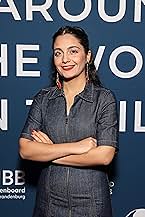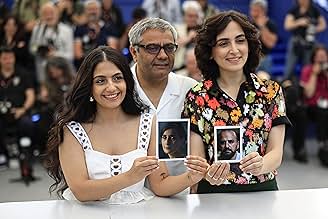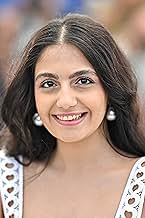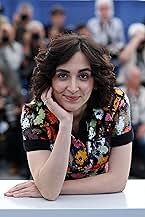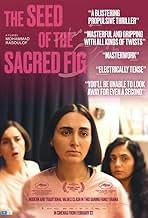Inmitten der politischen Unruhen in Teheran kämpft der Untersuchungsrichter Iman mit Paranoia. Als seine Waffe verschwindet, verdächtigt er seine Frau und seine TöchterInmitten der politischen Unruhen in Teheran kämpft der Untersuchungsrichter Iman mit Paranoia. Als seine Waffe verschwindet, verdächtigt er seine Frau und seine TöchterInmitten der politischen Unruhen in Teheran kämpft der Untersuchungsrichter Iman mit Paranoia. Als seine Waffe verschwindet, verdächtigt er seine Frau und seine Töchter
- Regie
- Drehbuch
- Hauptbesetzung
- Für 1 Oscar nominiert
- 36 Gewinne & 71 Nominierungen insgesamt
Empfohlene Bewertungen
There are still places on this Earth where women risk death for committing the irremissible crime of bareheadedness; of not wearing enough fabric to God's supposed liking. Such was the case of Mahsa Amini, the Iranian woman who died in the hospital (from "unrelated causes", as the sorts of people we see in this film would try to tell us -- and themselves) after being arrested for not wearing her hijab in public, escalating the ongoing Girls of Enghelab protests to the point of major unrest that lasted from September of 2022 and all the way into the spring of 2023.
In The Seed of the Sacred Fig, directed by Mohammad Rasoulof (the Iranian filmmaker who has often found himself at odds with his government and currently resides in exile in Germany), the events are seen from the perspective of the family of an investigating judge in Tehran. Throughout the film, real TikTok and Instagram videos of the bedlam are interwoven with the narrative. The unrest is reflected in this family; the daughters question the authorities and traditions that their parents protect for little reason other than tradition itself -- and yes, a point of violence is reached.
This is a tense, atmospheric, moving film. I don't wish to reveal too much about it, but I will say this: if this film becomes as big and impactful as it ought to be, its recurring phrase "I won't sit" may get co-opted by many equal rights/freedom movements to come.
Many Oscar opinion-havers this season have quipped, "I don't care who wins; I just need Emilia Pérez to lose". This concerns all categories that it's (somehow) nominated within, including Best International Feature Film. I guess I don't care who wins either. But it should be The Seed of the Sacred Fig.
In The Seed of the Sacred Fig, directed by Mohammad Rasoulof (the Iranian filmmaker who has often found himself at odds with his government and currently resides in exile in Germany), the events are seen from the perspective of the family of an investigating judge in Tehran. Throughout the film, real TikTok and Instagram videos of the bedlam are interwoven with the narrative. The unrest is reflected in this family; the daughters question the authorities and traditions that their parents protect for little reason other than tradition itself -- and yes, a point of violence is reached.
This is a tense, atmospheric, moving film. I don't wish to reveal too much about it, but I will say this: if this film becomes as big and impactful as it ought to be, its recurring phrase "I won't sit" may get co-opted by many equal rights/freedom movements to come.
Many Oscar opinion-havers this season have quipped, "I don't care who wins; I just need Emilia Pérez to lose". This concerns all categories that it's (somehow) nominated within, including Best International Feature Film. I guess I don't care who wins either. But it should be The Seed of the Sacred Fig.
The seed of the sacred fig is the first relevant, powerful film about the Iranian rebelion that took place in 2022. The Woman, Life, Freedom's movement was born right after the arrest and death of Jina Mahsa Amini, a student that did nothing but remove her veil. The director takes us down to a family of an Iranian judge (working for the State and the Mollah 's regime) who is about to receive a promotion that is supposed to change his life right at the moment the 2022 revolution starts. We spectators somehow live this key period of Iran through the eyes of this middle class family which is about to upgrade its living conditions. We are emerged in their every day life until the gun of the father (the judge) disapears or gets stolen inside their home.
The film features a fantastic script, wonderful actors and images of an unknown Iran. You can see Iran like we can rarely see it, with its modernity, its rich history and ancient monuments, its poverty as well as its drawbacks. Like in many Iranian films, the spectator is plunged into complex situations with ethical questions which oblige to choose between moral, personal values and loyalty to the regime: Shall I wear this veil or another (less provokative one) ? Should I go the university despite of the strikes ? Shoulld I ask a favor to my neighbor and take the risk of revealing my family's problems? The ethical questions are everywehre, and they are direct consequences of the heavy oppressive regime that has ruled Iran for now decades. All these questions are faced with dignity and sense of duty by the characters , with sometimes even loyalty towards a regime who could not care less about its people. Through these situations are revealed the lack of freedom, the oprression over women, the complicity of those who take profit of this regime and of course the brutality of a regime condemned to sacrifice its own people in order to survive.
The latter will be perfectly depicted through the fate of the father willing to do his job respectfully but obliged to corrupt himself and sacrifice his people in order to survive to this revolution no matter how painful it is.
I particularly enjoyed the insight into the Iranian middle class. Being able to see and imagine what is an every day life for women in Iran is difficult to figure from the Western World. The more the film lenghts the better it gets as you can clearly see the impasse into which the country has plunged, and with it its inhabitants (and in this case this family) condemned to find a guilty among them.
Little by little, we can spot the seeds of discord germinating in this family, into the society, among students, and throughout the world thanks to social networks. That's the other revelation of this film. Social network is the key; that's the tool through which the song Baraye resonates, as well as images of police violence are spread, proofs of the oppression are accumulated, they are the hopes of Iran. The regime can no longer hide behind outrageous lies, the seeds of rebellion are now spread everywhere and the complice of the regime can no longer hide.
A promising outcry and a promising motto for the future Iranian society: Woman, Life, Freedom that we hope, will eventually change Iran for good.
The film features a fantastic script, wonderful actors and images of an unknown Iran. You can see Iran like we can rarely see it, with its modernity, its rich history and ancient monuments, its poverty as well as its drawbacks. Like in many Iranian films, the spectator is plunged into complex situations with ethical questions which oblige to choose between moral, personal values and loyalty to the regime: Shall I wear this veil or another (less provokative one) ? Should I go the university despite of the strikes ? Shoulld I ask a favor to my neighbor and take the risk of revealing my family's problems? The ethical questions are everywehre, and they are direct consequences of the heavy oppressive regime that has ruled Iran for now decades. All these questions are faced with dignity and sense of duty by the characters , with sometimes even loyalty towards a regime who could not care less about its people. Through these situations are revealed the lack of freedom, the oprression over women, the complicity of those who take profit of this regime and of course the brutality of a regime condemned to sacrifice its own people in order to survive.
The latter will be perfectly depicted through the fate of the father willing to do his job respectfully but obliged to corrupt himself and sacrifice his people in order to survive to this revolution no matter how painful it is.
I particularly enjoyed the insight into the Iranian middle class. Being able to see and imagine what is an every day life for women in Iran is difficult to figure from the Western World. The more the film lenghts the better it gets as you can clearly see the impasse into which the country has plunged, and with it its inhabitants (and in this case this family) condemned to find a guilty among them.
Little by little, we can spot the seeds of discord germinating in this family, into the society, among students, and throughout the world thanks to social networks. That's the other revelation of this film. Social network is the key; that's the tool through which the song Baraye resonates, as well as images of police violence are spread, proofs of the oppression are accumulated, they are the hopes of Iran. The regime can no longer hide behind outrageous lies, the seeds of rebellion are now spread everywhere and the complice of the regime can no longer hide.
A promising outcry and a promising motto for the future Iranian society: Woman, Life, Freedom that we hope, will eventually change Iran for good.
Where do I even begin ?.. Words like freedom and dignity are not just mere words but they carry in them the deepest pain and suffering of all of humanity, Pain and suffering that were unawaredly endured for thousands of years through social and all kinds of oppression at the hands of a few oppressors and many a times by the very social norms that the humanity had laid out for itself through the truncated understanding of its own social condition in the larger scheme of collective human existence, how do you even go about freeing yourself from the clutches laid out by the collective oppression that has become your identity and the very means to your existence, how do you even go about waking up the society to the cultural cruelty that it's inflicting on its own cultural freedom and social well-being, The seed of the scared fig is not just a movie about Iran and it's women and their struggle over theocratical oppression to expand the social space for their personal freedom to reach the realms of human dignity and it's social acknowledgement, it's a much deeper study on the conflict that arises between the all empowered state through whatever social dictum and the individual freedom which forms the basis of the creation of the sub-unit called family, the very basis on which societies as such come into existence and seek to thrive in various forms and colours...This movie carries a seed in it that humanity needs to cherish for its own better future ...
The Seed of the Sacred Fig was one of the most expected premieres in Cannes due to the backstory of its creation. A film shot in secret in Iran, that led to its director and cast being sentenced to prison and lashing. So, would the movie be able to live up to the expectations despite its complicated production?
What followed was not a film, it was a MOLOTOV COCKTAIL! An incredibly brave, powerful and moving tale of morality, paranoia and resistance. The third act had people talking, but makes perfect sense to me in its symbolic context. If before the movie Rasoulof and his crew already received a big standing ovation due to the film's background, the emotive standing ovation it received after the screening was even more enthusiastic, with the also Iranian director and fellow Palme competitor Ali Abassi encouraging people to stand up and cheer.
The Seed of the Scared Fig did, unfortunately, not win the Palme d'Or in the end, and had to settle for a minor Special Jury Prize. But still, it would have been my choice for the main prize, and won over my and many other people's hearts. Women, Life, Freedom!
What followed was not a film, it was a MOLOTOV COCKTAIL! An incredibly brave, powerful and moving tale of morality, paranoia and resistance. The third act had people talking, but makes perfect sense to me in its symbolic context. If before the movie Rasoulof and his crew already received a big standing ovation due to the film's background, the emotive standing ovation it received after the screening was even more enthusiastic, with the also Iranian director and fellow Palme competitor Ali Abassi encouraging people to stand up and cheer.
The Seed of the Scared Fig did, unfortunately, not win the Palme d'Or in the end, and had to settle for a minor Special Jury Prize. But still, it would have been my choice for the main prize, and won over my and many other people's hearts. Women, Life, Freedom!
To better understand the concept behind the film, this might help, learn where the name of the film comes from:
There are plants known as "strangler figs" that exhibit strange behavior. Strangler figs (genus *Ficus*) begin their life as seeds deposited on the branches of a host tree, typically by birds or other animals. The seeds germinate and send down roots that eventually reach the ground. As the roots grow and thicken, they encircle the host tree, creating a lattice-like structure.
Over time, the strangler fig's roots and branches grow larger and more robust, competing with the host tree for sunlight and nutrients. Eventually, the fig's growth can become so extensive that it constricts the host tree's trunk, restricting its ability to transport water and nutrients. This process can lead to the host tree's death, effectively allowing the strangler fig to take over the space and resources previously used by the host.
The strangler fig does not immediately kill the host tree but rather slowly overcomes it through a combination of physical encasement and competition for resources. This fascinating but destructive relationship highlights a unique strategy in the plant kingdom for survival and growth.
Over time, the strangler fig's roots and branches grow larger and more robust, competing with the host tree for sunlight and nutrients. Eventually, the fig's growth can become so extensive that it constricts the host tree's trunk, restricting its ability to transport water and nutrients. This process can lead to the host tree's death, effectively allowing the strangler fig to take over the space and resources previously used by the host.
The strangler fig does not immediately kill the host tree but rather slowly overcomes it through a combination of physical encasement and competition for resources. This fascinating but destructive relationship highlights a unique strategy in the plant kingdom for survival and growth.
Wusstest du schon
- WissenswertesDirector Mohammad Rasoulof was originally scheduled to take part in the 2023 Cannes Film Festival as a jury member of the Un Certain Regard section. However, he was arrested in July 2022 after criticising the government's crackdown on protestors in the southwestern city of Abadan in Iran over deadly building collapse. On May 8, 2024, Rasouloff's lawyer announced that he has been sentenced to eight years in prison as well as flogging, a fine and confiscation of his property. On May 12, 2024, Rasouloff announced that he managed to flee Iran and was staying at an undisclosed location in Europe. On May 24, 2024, Rasouloff attended the film's premiere in Cannes and on the red carpet he held up photos of two of the film's actors, Soheila Golestani and Missagh Zareh.
- Crazy CreditsOpening credits: "Ficus Religiosa is a tree with an unusual life cycle. It seeds, contained in bird droppings, fall on other trees. Aerial roots spring up and grow down to the floor. Then, the branches wrap around the host tree and strangle it. Finally, the sacred fig stands on its own."
- VerbindungenFeatured in 82nd Golden Globe Awards (2025)
Top-Auswahl
Melde dich zum Bewerten an und greife auf die Watchlist für personalisierte Empfehlungen zu.
Details
Box Office
- Bruttoertrag in den USA und Kanada
- 860.139 $
- Eröffnungswochenende in den USA und in Kanada
- 35.230 $
- 1. Dez. 2024
- Weltweiter Bruttoertrag
- 6.586.490 $
- Laufzeit2 Stunden 47 Minuten
- Farbe
- Sound-Mix
- Seitenverhältnis
- 2.35 : 1
Zu dieser Seite beitragen
Bearbeitung vorschlagen oder fehlenden Inhalt hinzufügen

Oberste Lücke
What is the Canadian French language plot outline for Die Saat des heiligen Feigenbaums (2024)?
Antwort


